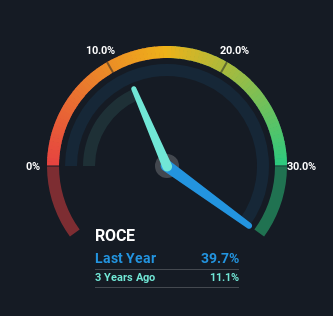- India
- /
- Electrical
- /
- NSEI:SCHNEIDER
Under The Bonnet, Schneider Electric Infrastructure's (NSE:SCHNEIDER) Returns Look Impressive

What trends should we look for it we want to identify stocks that can multiply in value over the long term? One common approach is to try and find a company with returns on capital employed (ROCE) that are increasing, in conjunction with a growing amount of capital employed. Ultimately, this demonstrates that it's a business that is reinvesting profits at increasing rates of return. Speaking of which, we noticed some great changes in Schneider Electric Infrastructure's (NSE:SCHNEIDER) returns on capital, so let's have a look.
What Is Return On Capital Employed (ROCE)?
For those that aren't sure what ROCE is, it measures the amount of pre-tax profits a company can generate from the capital employed in its business. To calculate this metric for Schneider Electric Infrastructure, this is the formula:
Return on Capital Employed = Earnings Before Interest and Tax (EBIT) ÷ (Total Assets - Current Liabilities)
0.40 = ₹2.7b ÷ (₹14b - ₹7.3b) (Based on the trailing twelve months to December 2023).
Thus, Schneider Electric Infrastructure has an ROCE of 40%. That's a fantastic return and not only that, it outpaces the average of 18% earned by companies in a similar industry.
View our latest analysis for Schneider Electric Infrastructure

Historical performance is a great place to start when researching a stock so above you can see the gauge for Schneider Electric Infrastructure's ROCE against it's prior returns. If you want to delve into the historical earnings , check out these free graphs detailing revenue and cash flow performance of Schneider Electric Infrastructure.
The Trend Of ROCE
We like the trends that we're seeing from Schneider Electric Infrastructure. Over the last five years, returns on capital employed have risen substantially to 40%. Basically the business is earning more per dollar of capital invested and in addition to that, 329% more capital is being employed now too. The increasing returns on a growing amount of capital is common amongst multi-baggers and that's why we're impressed.
In another part of our analysis, we noticed that the company's ratio of current liabilities to total assets decreased to 52%, which broadly means the business is relying less on its suppliers or short-term creditors to fund its operations. Therefore we can rest assured that the growth in ROCE is a result of the business' fundamental improvements, rather than a cooking class featuring this company's books. Nevertheless, there are some potential risks the company is bearing with current liabilities that high, so just keep that in mind.
What We Can Learn From Schneider Electric Infrastructure's ROCE
All in all, it's terrific to see that Schneider Electric Infrastructure is reaping the rewards from prior investments and is growing its capital base. And a remarkable 632% total return over the last five years tells us that investors are expecting more good things to come in the future. So given the stock has proven it has promising trends, it's worth researching the company further to see if these trends are likely to persist.
On a final note, we've found 1 warning sign for Schneider Electric Infrastructure that we think you should be aware of.
High returns are a key ingredient to strong performance, so check out our free list ofstocks earning high returns on equity with solid balance sheets.
New: Manage All Your Stock Portfolios in One Place
We've created the ultimate portfolio companion for stock investors, and it's free.
• Connect an unlimited number of Portfolios and see your total in one currency
• Be alerted to new Warning Signs or Risks via email or mobile
• Track the Fair Value of your stocks
Have feedback on this article? Concerned about the content? Get in touch with us directly. Alternatively, email editorial-team (at) simplywallst.com.
This article by Simply Wall St is general in nature. We provide commentary based on historical data and analyst forecasts only using an unbiased methodology and our articles are not intended to be financial advice. It does not constitute a recommendation to buy or sell any stock, and does not take account of your objectives, or your financial situation. We aim to bring you long-term focused analysis driven by fundamental data. Note that our analysis may not factor in the latest price-sensitive company announcements or qualitative material. Simply Wall St has no position in any stocks mentioned.
About NSEI:SCHNEIDER
Schneider Electric Infrastructure
Designs, manufactures, builds, and services products and systems for electricity distribution in India and internationally.
Excellent balance sheet with limited growth.
Market Insights
Community Narratives



